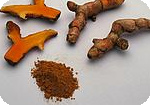| Tuesday, 13 May 2025 Home • About Us • Contact Us |
|
|
|
You are here:
Eating foods rich in the curry spice, turmeric, could offer relief to sufferers of tennis elbow and other forms of the inflammatory condition tendonitis, says new research.
Turmeric is used in curries and other Indian dishes. Its active ingredient, curcumin, which gives turmeric its bright yellow coloring, is responsible for its unique healing properties. It has already been well researched for its cancer-fighting and anti-inflammatory properties, and this new piece of research adds to that list. This study has found that turmeric can be used to suppress biological mechanisms that spark inflammation in tendon diseases. One of the co-researchers said:
Tendons, the tough cords of fibrous connective tissue that join muscles to bones, are essential for movement because they transfer the force of muscle contraction to bones but are prone to injury, particularly in athletes. Tendinitis (or tendonitis) is a form of tendon inflammation, which causes pain and tenderness near to joints and is particularly common in shoulders, elbows, knees, hips, heels or wrists. Other examples of common tendon disease include tennis and golfer's elbow and Achilles tendinitis. At present, standard treatment aims to relieve pain and reduce inflammation using non-steroidal anti-inflammatory drugs (NSAIDS), such as aspirin or ibuprofen. In more serious cases of tendon injury, steroid injections can be given directly into the tendon sheath to control pain and enable physical therapy to start. However, NSAIDS and steroids are associated with undesired side effects including stomach ulcers, nausea, vomiting, heartburn, headache, diarrhea, constipation, drowsiness and fatigue. As the researchers said, there is an acute need for new treatments with fewer debilitating side effects. Study Details This latest research looked at curcumin, a key ingredient of the spice turmeric, which has been used for centuries as an anti-inflammatory agent and remedy for symptoms related to irritable bowel syndrome and other disorders. In the laboratory, researchers used a culture model of human tendon inflammation to study the anti-inflammatory effects of curcumin on tendon cells. The main objective of the study was to observe the effects that curcumin had on the inflammatory and degenerative properties induced by signaling molecules called interleukins. Interleukins are a type of small cell-signalling protein molecules called cytokines that can activate a whole series of inflammatory genes by triggering a dangerous 'switch' called NFkB. The results showed that introducing curcumin in the culture system inhibits NFkB and prevents it from switching on and promoting further inflammation. Previous research suggests turmeric may be useful in a variety of conditions, including cancer, arthritis and Alzheimer's. However, experts say it is difficult to get a big enough dose to remedy medical problems from a curry meal, as 100g of curry powder has to be eaten to deliver a 3.6g clinical dose. Research Paper Details: C. Buhrmann, A. Mobasheri, F. Busch, C. Aldinger, R. Stahlmann, A. Montaseri, M. Shakibaei. Curcumin Modulates Nuclear Factor B (NF- B)-mediated inflammation in Human Tenocytes in Vitro: ROLE OF THE PHOSPHATIDYLINOSITOL 3-KINASE/Akt PATHWAY. Journal of Biological Chemistry, 2011; 286 (32): 28556.
Link to this article: Show: HTML Link • Full Link • Short Link
Related Articles:
You must be registered and logged in to comment. |
|
 |
 | |
|
|

 "Our research is not suggesting that curry,
"Our research is not suggesting that curry, 






